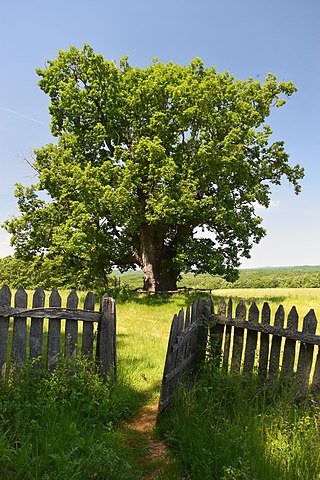
Quercus frainetto, commonly known as the Hungarian oak, is a species of oak, native to southeastern Europe and Turkey. It is classified in Quercus sect. Quercus.
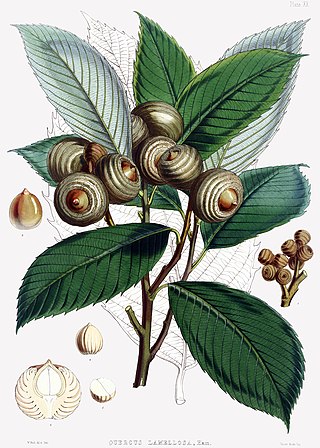
Quercus lamellosa is a species of oak (Quercus) native to the Himalaya and adjoining mountains from Tibet and Nepal east as far as Guangxi and northern Thailand, growing at altitudes of 1300–2500 m. The Lepcha of Sikkim call it book koong. It is placed in subgenus Cerris, section Cyclobalanopsis.
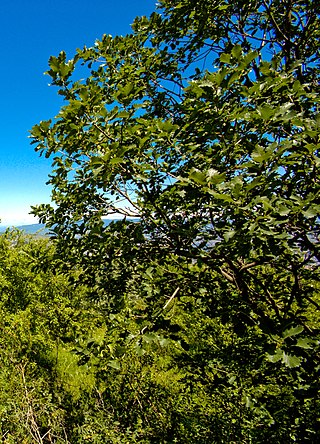
Quercus macranthera, commonly called the Caucasian oak, or the Persian oak, is a species of deciduous tree native to Western Asia that is occasionally grown as an ornamental tree in Europe growing to 30 metres tall. It is placed in section Quercus.

Quercus libani, the Lebanon oak, is a species of oak native to the eastern Mediterranean in western Asia, including in Lebanon, western Syria, northeastern Israel, eastern Turkey, and northern Iraq and Iran.
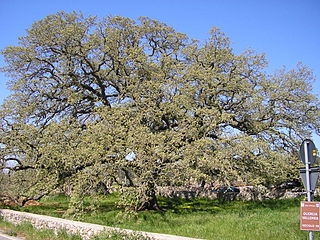
Quercus ithaburensis subsp. macrolepis, the Valonia oak, is a subspecies of Quercus ithaburensis, a member of the beech family, Fagaceae. It may also be treated as a separate species, Quercus macrolepis.

Quercus ithaburensis, the Mount Tabor oak, is a tree in the beech family Fagaceae. It is found from southeastern Italy to the Palestine region. It is the national tree of Jordan. Two subspecies are accepted, Quercus ithaburensis subsp. ithaburensis and Quercus ithaburensis subsp. macrolepis. Together with Quercus brantii, it forms a clade of distinct, closely related species within the oak section Cerris.
Quercus helferiana is a species of tree in the beech family Fagaceae. It is native to Vietnam, Thailand, Laos, Myanmar, India (northeast), and southern China. It is placed in subgenus Cerris, section Cyclobalanopsis.

Quercus vulcanica is a species of flowering plant in the Fagaceae family. It is referred to by the common name Kasnak oak, and is a rare species of tree native to Lebanon, Syria, and Turkey. It is placed in section Quercus.
Quercus ungeri is a species of flowering plant in the family Fagaceae, native to north-west Iran. It was first described by Theodor Kotschy in 1858. It is placed in Quercus section Cerris.

Quercus longinux is an uncommon Asian species of trees in the beech family Fagaceae. It has only been found in Taiwan. It is placed in subgenus Cerris, section Cyclobalanopsis.
Quercus saravanensis is an Asian species of tree in the beech family Fagaceae. It has been found in northern Indochina, and also in the Province of Yunnan in southwestern China. It is placed in subgenus Cerris, section Cyclobalanopsis.
Quercus thorelii is an Asian species of tree in the beech family Fagaceae. The species is named after the French botanist Clovis Thorel. It has been found in Indochina and in southern China. It is placed in subgenus Cerris, section Cyclobalanopsis, the ring-cupped oaks.

Quercus × crenata is a tree in the family Fagaceae. It is treated as a hybrid between the European trees Turkey oak and cork oak but may also represent a distinct species. In the past, it has often been called Quercus × hispanica, a name that properly refers to presumed hybrids between Portuguese oak and Quercus suber.
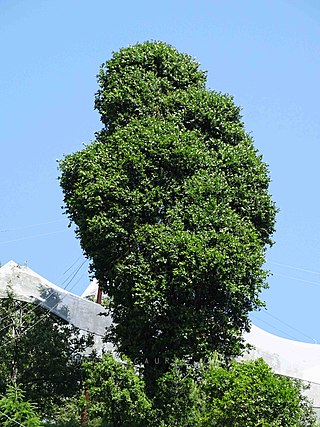
Quercus floribunda, called the Moru oak or Mohru oak, Tilonj oak and green oak, is a species of oak native to Afghanistan, Pakistan, India's western Himalaya, and Nepal, typically found from 2,000 to 3,000 metres above sea level. It is in the subgenus Cerris, section Ilex. An evergreen tree with a dense crown reaching 30 m (98 ft), it is an important fuelwood and fodder species.
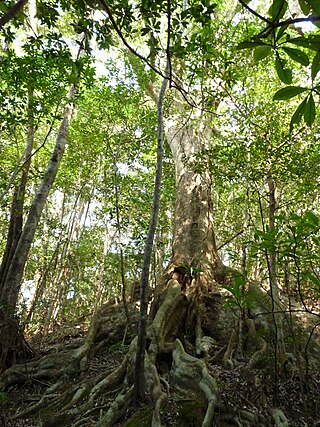
Quercus miyagii is a species of oak native to the Ryukyu Islands. It is placed in subgenus Cerris, section Cyclobalanopsis.
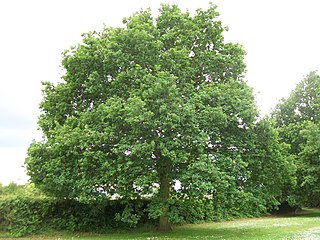
Quercus subgenus Quercus is one of the two subgenera into which the genus Quercus was divided in a 2017 classification. It contains about 190 species divided among five sections. It may be called the New World clade or the high-latitude clade; most species are native to the Americas, the others being found in Eurasia and northernmost North Africa.

Quercus subgenus Cerris is one of the two subgenera into which the genus Quercus was divided in a 2017 classification. It contains about 140 species divided among three sections. It may be called the Old World clade or the mid-latitude clade; all species are native to Eurasia and North Africa.
Quercus kotschyana is a species of oak endemic to the mountains of Lebanon. It is placed in subgenus Quercus, section Quercus.













